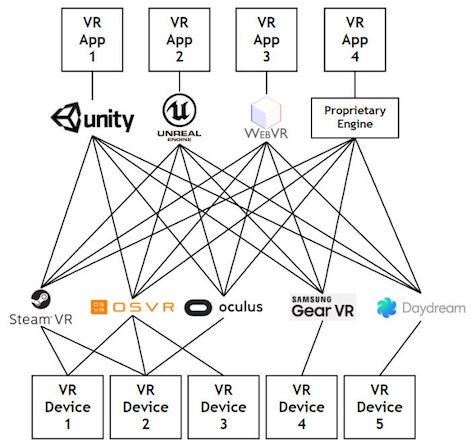Some of the leading names in the industry have come together to form a working group with the objective of establishing an open standard for VR and AR. And now we know that standard will be called OpenXR. The group aims to create an open and royalty-free standard for VR and AR applications and devices with the aim of encouraging innovation while accelerating market growth and user adoption.
Led by Khronos, the group includes many of the major players from platform holders and hardware manufacturers to game engines and developers. Partners include Valve, Google, Samsung, Epic Games, Unity, Sony, nVidia, and AMD.
Why Standardise?
The initiative has been formed to eliminate API fragmentation leading to application developers having to spend time, money, and resources integrating a variety of hardware. The easier it is to publish on multiple platforms, the faster new content will reach the market, resulting not only in increased profitability in the short-term, but also a broader library of content to attract consumers and grow revenue in the long-term.


How OpenXR Will Work
The OpenXR standard comes in two parts. First, the Application Interface, which application developers and middleware providers write to, and which serves to define and combine common, cross-platform functionality. This enables application developers to write code once that will run everywhere, to focus on innovating in their applications, and to not have to support multiple interfaces for a diversity of different devices.
Next, the Device Layer allows VR/AR runtimes to interface with various devices. If a hardware manufacturer wants to add support for a new device, they implement code that conforms to Device Layer specification, and their hardware will be immediately compatible with the applications written for the Application Layer. This is a powerful architecture that enables everyone to focus on what’s most important to them.
The OpenXR standard is being designed to enable a rich diversity of implementation differentiation between vendors. Runtimes from various vendors might differ in performance and capabilities, but having these runtime implementations support the same standard interfaces results in significantly more choice for end-users.

Partners
In order for any standardisation effort like OpenXR to be successful, it needs input from a wide variety of design perspectives from all sides of the problem space. The OpenXR working group has assembled a great group of leading companies in order to ensure that this standard will genuinely meet the needs of the industry.

Here's what some of the key players have to say about OpenXR:
Tim Sweeney, Founder & CEO at Epic Games
“With VR on the verge of rapid growth across all of the major platform families, this new Khronos open standards initiative is very timely. We at Epic Games will wholeheartedly contribute to the effort, and we'll adopt and support the resulting API in Unreal Engine.”
Mike Jazayeri, Director Product Management at Google VR
“Open standards which allow developers to more easily create compelling, cross platform experiences will help bring the magic of VR to everyone. We look forward to working with our industry colleagues on this initiative.”
John Carmack, CTO at Oculus
“Khronos’ open APIs have been immensely valuable to the industry, balancing the forces of differentiation and innovation against gratuitous vendor incompatibility. As Virtual Reality matures and the essential capabilities become clear in practice, a cooperatively developed open standard API is a natural and important milestone. Oculus is happy to contribute to this effort.”
Gabe Newell, Valve
“The number of VR systems on the market is growing rapidly. Most of these require separate API support from the developer, which is causing huge fragmentation for consumers. Khronos’ work on a standard API to enable applications to target a wide variety of VR devices is an important step to counter that trend.”
You’ll notice one surprising logo that’s missing though – HTC Vive. Long seen as champions for an open industry without walled gardens and exclusives, surely this initiative is in line with the Korean firm’s strategy? A spokesperson for HTC Vive said, ““We share the same vision as Khronos with keeping VR an open platform, and are currently working with Khronos to formally join their initiative and membership.”
Does The World Need Another Acronym?
OpenXR. As in, ‘Open standard for (X) Reality'. We’re usually among the first to object to yet another acronym to stand alongside VR, AR, MR – and even HR - but as an umbrella term to encompass all immersive media, we can get on board with XR if the end result is clarity for consumers. Will the industry, retail and media adopt the XR terminology? We shall see...
You can find the latest details on OpenXR here.













